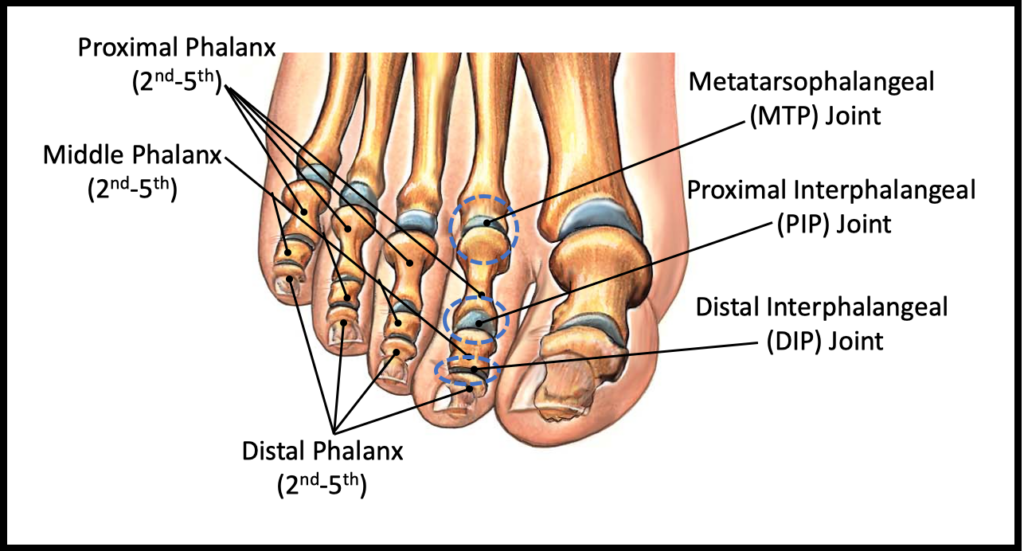Almost everyone has suffered a stub toe at some point. You inadvertently smash your foot into a solid object -often at night when you’re half asleep. A swear word may be uttered! Almost immediately searing pain emanates from the stubbed toe or toes that have been injured. A marked limp ensues. So, what actually happens when you stub your toe?
There’s no such thing as a “good stubbed toe“. However, some stubbed toes are more manageable than others. So, let’s think of the extent of the injury, in terms of those that are manageable; those that are bad; and those that are ugly!
Anatomy of the Toes
To understand a stubbed toe it is important to understand a bit about the anatomy of the toes -and the physiology of an injury. The four smaller toes are called the “lesser toes“. They are each made up of three bones, the phalanges -and there are three associated joints (Figure 1). The joints are held together by strong soft tissues called ligaments. All the lesser toes are fairly mobile, although they tend to mostly move up-and-down rather than side to side. The toes move during walking due to ground reactive forces or when pulled by one of the tendons that acts on the toes.

The types of injuries that often occur with a stubbed toe include: bruising; tearing of one of the joint ligaments, or a fracture of one of the toe bones. All of these injuries will elicit a physiological response with the body sending increased blood flow to the area as part of the healing response. This is both good and bad. You need the increased blood flow to bring the healing elements to the injured area. However, toes are relatively confined structures and don’t tolerate too much swelling. So, the blood flow causes swelling, which unfortunately exacerbates the pain. It is helpful to think about a stubbed toe in terms of the severity of the injury.
The Manageable Stubbed Toe
Fortunately, most toes are in the manageable category. They are essentially a bad bruise to the involved toe or toes. Sometimes some partial tearing of one of the joint ligaments may occur, but not enough to destabilize the joint. Patients will need to deal with pain and swelling for a day or two or even up to a week. However, with no major injury, and no associated deformity, the toe will settle –usually with no residual symptoms. Initial treatment would include limiting activities, using a stiff shoe with a wide toebox, and possibly icing the toe. If there are no contra-indications an anti-inflammatory medication may be taken to help reduce the pain.
The Bad Stubbed Toe
A bad stubbed toe can be more challenging with a longer recovery. This type of injury usually involves a fracture of one of the phalangeal bones and/or notable tearing of one or more of the joint ligaments. The swelling and pain can be intense and symptoms can persist for many weeks. However, without a significant deformity of the bones or joints conservative treatment will be successful. Helpful treatment includes limiting weight-bearing activities, elevating the foot to decrease swelling, using a stiff shoe with a wide toebox, icing as needed, and possibly taking anti-inflammatory medication to help the discomfort. Recovery can take many weeks and some residual stiffness of one or more of the joints is not uncommon.
The Ugly Stubbed Toe
The “ugly” stubbed toe is problematic! Fortunately, this level of severity is not that common. The vast majority of stubbed toes are just painful, but will not require intervention. However, if the injury is such that a displaced or significantly angulated fracture has occurred and/or there is a dislocation of one of the joints of the toe then more involved intervention may be required. In addition, any “open injury” where a fractured bone has poked through the skin and is exposed to the outside world would also create a “ugly” stubbed toe. If there is an obvious angular or rotational deformity to the toe this will usually need to be treated. Sometimes, a doctor will be able to freeze up the toe and gently pull on it to straighten it. The straightened toe is then “buddy taped” to the toe beside it. In rare instances, surgery may be required to formally straighten the toe and stabilize it in the appropriate position. In patients where a fractured bone has poked through the skin surgery may be required, as well as a course of antibiotics in order to minimize the risk of infection. Needless to say an “ugly” stubbed toe is a frustrating injury that has a prolong recovery time and often leads to residual stiffness. Fortunately, these types of more extensive toe injuries are relatively uncommon.
It’s always best to prevent an injury. So, give some thought about structures in your home that could be a stubbed toe hazard! Hopefully, you can avoid this type of injury, but, if you’re unfortunate enough to be a victim of a stubbed toe, hopefully this overview will help.
April 4th, 2024
